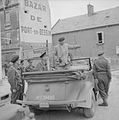Port-en-Bessin-Huppain
Appearance
You can help expand this article with text translated from the corresponding article in French. (December 2008) Click [show] for important translation instructions.
|
Port-en-Bessin-Huppain | |
|---|---|
 Port-en-Bessin-Huppain, seen from above the Vauban Tower | |
| Coordinates: 49°20′42″N 0°45′14″W / 49.345°N 0.7539°W | |
| Country | France |
| Region | Normandy |
| Department | Calvados |
| Arrondissement | Bayeux |
| Canton | Bayeux |
| Government | |
| • Mayor (2008—2014) | Pierre-Albert Cavey |
Area 1 | 7.56 km2 (2.92 sq mi) |
| Population (2008) | 2,080 |
| • Density | 280/km2 (710/sq mi) |
| Time zone | UTC+01:00 (CET) |
| • Summer (DST) | UTC+02:00 (CEST) |
| INSEE/Postal code | 14515 /14520 |
| Elevation | 0–74 m (0–243 ft) (avg. 50 m or 160 ft) |
| 1 French Land Register data, which excludes lakes, ponds, glaciers > 1 km2 (0.386 sq mi or 247 acres) and river estuaries. | |
Port-en-Bessin-Huppain is a commune in the Calvados department in the Normandy region in northwestern France.
The commune contains the two towns of Port-en-Bessin and Huppain.
Population
| Year | Pop. | ±% |
|---|---|---|
| 1793 | 580 | — |
| 1800 | 540 | −6.9% |
| 1806 | 628 | +16.3% |
| 1821 | 550 | −12.4% |
| 1831 | 630 | +14.5% |
| 1836 | 674 | +7.0% |
| 1841 | 676 | +0.3% |
| 1846 | 782 | +15.7% |
| 1851 | 842 | +7.7% |
| 1856 | 812 | −3.6% |
| 1861 | 870 | +7.1% |
| 1866 | 928 | +6.7% |
| 1872 | 1,001 | +7.9% |
| 1876 | 1,020 | +1.9% |
| 1881 | 1,129 | +10.7% |
| 1886 | 1,164 | +3.1% |
| 1891 | 1,272 | +9.3% |
| 1896 | 1,354 | +6.4% |
| 1901 | 1,447 | +6.9% |
| 1906 | 1,443 | −0.3% |
| 1911 | 1,456 | +0.9% |
| 1921 | 1,335 | −8.3% |
| 1926 | 1,316 | −1.4% |
| 1931 | 1,408 | +7.0% |
| 1936 | 1,494 | +6.1% |
| 1946 | 1,314 | −12.0% |
| 1954 | 1,560 | +18.7% |
| 1962 | 1,737 | +11.3% |
| 1968 | 1,891 | +8.9% |
| 1975 | 2,388 | +26.3% |
| 1982 | 2,332 | −2.3% |
| 1990 | 2,308 | −1.0% |
| 1999 | 2,139 | −7.3% |
| 2008 | 2,080 | −2.8% |
History
The name Huppain stems from Norse/Norwegian Oppheim, reflecting the general Viking history of Normandy.
The town was captured by Royal Marines of No. 47 (Royal Marine) Commando in Operation Aubery during the Normandy landings and used as the terminal for PLUTO (Pipe-Lines Under The Ocean).[1]
Media

Port-en-Bessin was used to represent nearby Ouistreham in the 1962 film The Longest Day.[2]
Sister cities
 Saint-Pierre, Saint Pierre and Miquelon, (France), since 1976.[3]
Saint-Pierre, Saint Pierre and Miquelon, (France), since 1976.[3]
See also
Gallery
-
Église Saint-Nicolas de Villiers-sur-Port
-
Bridge and port of Port-en-Bessin-Huppain, by Georges Seurat, 1888
-
General Montgomery with Army and Royal Navy officers in Port-en-Bessin, 10 June 1944 in the Normandy Campaign
References
- ^ "D-Day: Heroic battle in Port-en-Bessin". Daily Telegraph. Retrieved 29 December 2013.
- ^ Notre jour le plus long La Presse de la Manche 2012
- ^ Jumelages
Wikimedia Commons has media related to Port-en-Bessin-Huppain.








